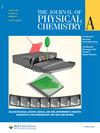Magnetic Circular Dichroism of Substoichiometric Molybdenum Oxide (MoO₃–ₓ) Nanoarchitectures with Polaronic Defects
IF 2.781
引用次数: 0
Abstract
Magnetic circular dichroism (MCD) is demonstrated for the first time in substoichiometric molybdenum oxide (MoO₃–ₓ) nanoarchitectures to explore the origin of their near-IR (NIR) transitions. Various nanostructures of MoO₃–ₓ are synthesized by a simple hydrothermal process using an ionic Mo(VI) or metallic Mo(0) precursor. The phase, morphology, and spectroscopic properties of the obtained nanostructures are dependent both on the reaction temperature and the molybdenum precursor. In particular, hexagonal MoO₃–ₓ nanostructures are colored blue with different degrees. To better understand the nature of the electronic states in these nanomaterials, MCD spectroscopy is conducted. A derivative-like MCD response is detected in the vis-NIR region, but it is not attributed to surface magnetoplasmonic modes because of the absence of the peak-energy shift with the increasing refractive index of the dispersion medium. Then, the bisignate MCD signal can be attributed to Faraday B-terms for small-polaronic transitions, arising from two interacting polaronic states close in energy that would give opposite signs under an applied magnetic field. We believe that MCD evaluation for polaronic nanomaterials will expand promising new applications in fields such as semiconductor-based nanophotonics and magneto-optical devices.具有极化合缺陷的亚化学计量氧化钼(MoO₃-ₓ)纳米结构的磁圆二色性
首次在亚化学计量的氧化钼(MoO₃-ₓ)纳米结构中证明了磁性圆二色性(MCD),以探索其近红外(NIR)跃迁的起源。采用离子Mo(VI)或金属Mo(0)前驱体,通过简单的水热法合成了多种MoO₃-ₓ纳米结构。所得纳米结构的相、形貌和光谱性质取决于反应温度和钼前驱体。特别是,六边形的MoO₃-ₓ纳米结构被不同程度地涂成蓝色。为了更好地了解这些纳米材料中的电子态的性质,进行了MCD光谱。在可见-近红外区域检测到类似导数的MCD响应,但它不是归因于表面磁等离子体模式,因为没有随色散介质折射率增加而出现的峰值能量位移。然后,双信号MCD信号可以归因于法拉第b项的小极化跃迁,由两个相互作用的极化态产生,能量接近,在外加磁场下会给出相反的符号。我们相信,极化纳米材料的MCD评估将在半导体纳米光子学和磁光器件等领域扩展有前途的新应用。
本文章由计算机程序翻译,如有差异,请以英文原文为准。
求助全文
约1分钟内获得全文
求助全文

 求助内容:
求助内容: 应助结果提醒方式:
应助结果提醒方式:


